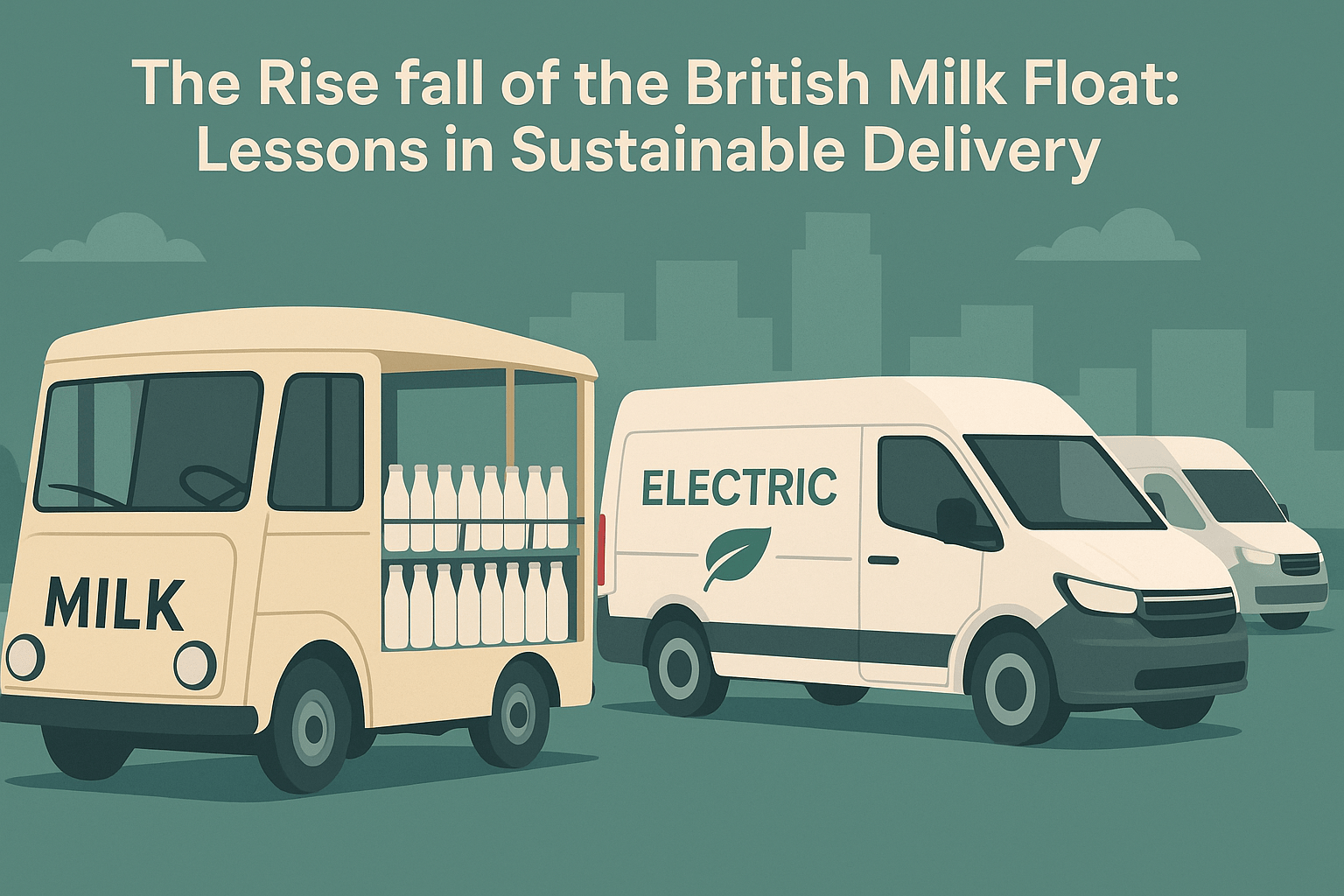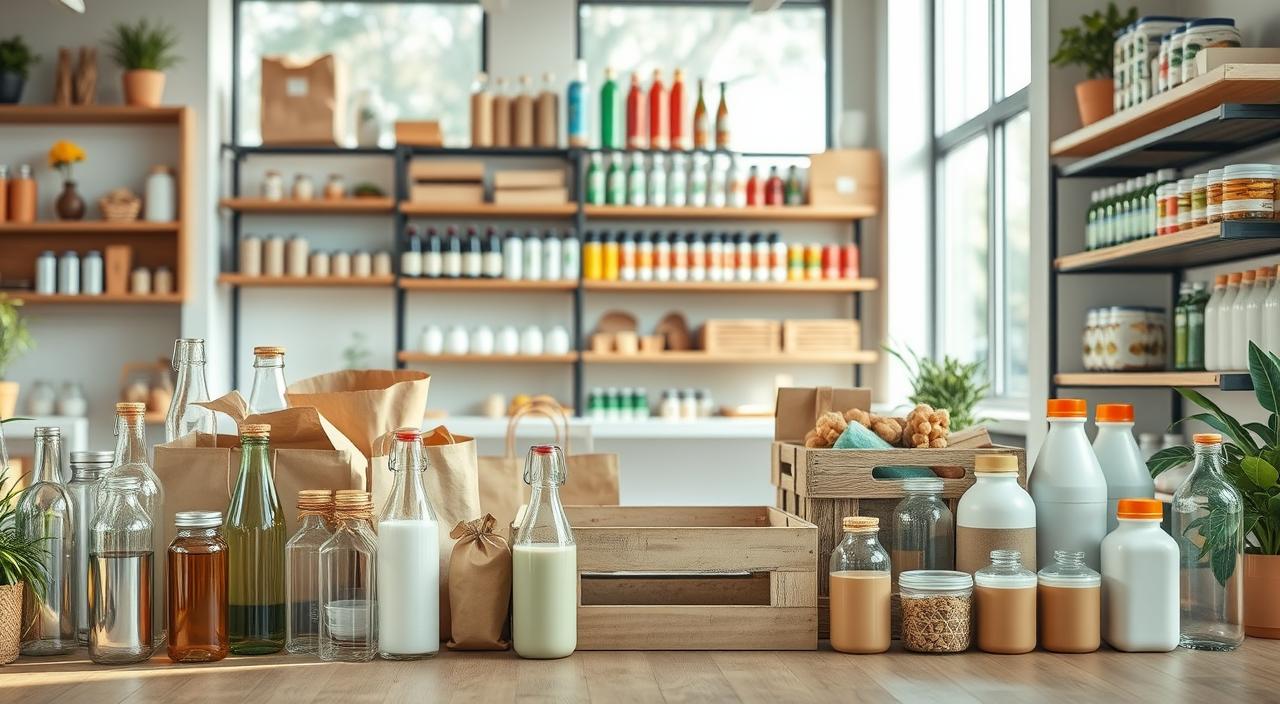
Once a daily fixture on Britain’s streets, the British milk float transformed doorstep deliveries decades before “green transport” became a marketing trend. These small electric vehicles glided silently through early-morning streets, delivering fresh milk without exhaust fumes or engine noise. In an era when transport is the UK’s largest source of greenhouse gas emissions and urban air quality is under threat, this retro delivery icon feels unexpectedly relevant again.

Transport produced 27% of the UK’s greenhouse gases in 2019, and with last-mile delivery demand projected to rise by 78% this decade, cities risk worsening congestion and pollution. The milk float’s early combination of clean energy and optimised routing offers practical lessons for today’s logistics sector.
Recent research shows 68% of British consumers prefer brands with strong environmental credentials. For businesses, sustainable delivery is no longer just a compliance issue — it’s an opportunity to innovate, cut costs, and win loyalty.
Key Takeaways
- Milk floats pioneered electric vehicle technology and route optimisation long before sustainability became mainstream.
- Last-mile delivery demand could grow 36% in cities by 2030 without intervention.
- 68% of UK consumers actively prefer eco-friendly brands.
- Transport generates over a quarter of Britain’s carbon emissions.
- Greener logistics are essential for air quality in urban areas.
The History and Legacy of the Milk Float
The sound of milk bottles clinking at dawn was once a universal experience in the UK. What began as horse-drawn carts in the 1920s evolved into efficient electric vehicles by the 1950s, becoming central to British community life.
From Horses to Electric Workhorses
In its earliest form, the milk float was powered by horses, covering short distances at walking pace. By the mid-20th century, electric models had taken over, offering 30–40 miles of range and operating almost silently. Their slow speed (max 15 mph) suited early-morning delivery rounds perfectly, and overnight charging meant they were always ready for service.
| Aspect | 1920s–1940s | 1950s–1980s |
|---|---|---|
| Power Source | Horses | Electric batteries |
| Daily Range | 5–8 miles | 30–40 miles |
| Noise Level | High (hooves) | Minimal |
| Delivery Window | Daylight hours | 3am–7am |
Route Efficiency Before GPS
Milkmen mastered route efficiency long before digital mapping. Fixed daily schedules meant 95% of customers received deliveries without missed stops. Orders were grouped by street, ensuring each float could serve more than 500 homes per week — a model that modern logistics companies now replicate to reduce emissions.
The milk round was about more than deliveries. Milkmen often collected payments for entire streets, knew every customer personally, and provided a reliable community service.
The Shift from Floats to Vans — and Back Again
As supermarket shopping and bulk deliveries became the norm, milk float usage declined, replaced by diesel vans. The result was more noise, more congestion, and higher emissions. Today, e-commerce has brought another challenge: the UK handled over 5.2 billion parcels in 2023, 25% more than in 2020.
Businesses face new pressures — both from regulations like clean air zones in London and Birmingham, and from consumers demanding greener delivery options. Rising fuel costs are another factor: electric vans can save around £6,000 per vehicle per year compared to diesel.
| Challenge | Old Approach | Modern Solution |
|---|---|---|
| Regulations | Ignore emissions limits | Switch to electric fleets |
| Fuel Costs | Diesel vehicles | Renewable energy charging |
| Consumer Demand | Speed over sustainability | Offer “green” delivery slots |
| Route Planning | Manual scheduling | AI-powered optimisation |
Modern Logistics Inspired by the British Milk Float Model
Forward-thinking companies are blending old-fashioned efficiency with cutting-edge technology. Sustainable delivery strategies focus on three main areas: cleaner vehicles, smarter packaging, and better route planning.
Greener Transport Choices
Electric vans and cargo bikes are becoming common in city logistics. In Bristol, trials of e-cargo bikes reduced route emissions by 61%. Couriers like Evri now run a third of certain routes with electric vehicles, cutting carbon output by 17.5% compared to 2020.
Advantages include:
- 42% lower fuel costs for electric fleets
- Up to 60% reduction in carbon emissions per shipment
- Higher customer satisfaction — 94% of surveyed customers preferred eco-friendly delivery services
Smarter Packaging and Waste Reduction
The UK uses around five million tonnes of plastic annually, with over 90% ending up in landfill. Businesses are turning to compostable mailers, recycled cardboard, and right-sized packaging to reduce waste.
| Material | Decomposition Time | Cost Premium |
|---|---|---|
| Standard Plastic | 450+ years | £0.00 |
| Cornstarch Packaging | 3 months | +18% |
| Recycled Cardboard | 2–5 months | +9% |
Right-sizing boxes reduces filler use, lowers shipping costs, and allows more packages per trip — cutting emissions and fuel bills.
How the British Milk Float Perfected Route Optimisation

Modern software analyses traffic, postcodes, and delivery windows to minimise mileage. A Leeds-based courier reduced fuel use by 30% and increased daily stops by 22% with optimised collection routes.
Tactics include:
- Grouping deliveries by postcode
- Scheduling rounds outside rush hours
- Predicting customer availability to avoid failed deliveries
Birmingham City Council’s redesigned waste collection routes cut emissions by 32 tonnes CO₂ per week using similar methods.
Lessons for Today from the Milk Float Era
The British milk float succeeded because it balanced efficiency, community trust, and environmental awareness (even if unintentionally). Today’s delivery sector can learn from this by:
- Consolidating orders to reduce trips
- Investing in zero-emission vehicles
- Optimising routes to cut fuel waste
- Communicating sustainability efforts clearly to customers
Transparency matters. Retailers like Waitrose and River Island now share carbon savings with customers, while offering incentives such as free slower “green” delivery slots.
Conclusion
The British milk float may have faded from daily life, but its legacy offers a powerful blueprint for sustainable logistics. These electric vehicles proved decades ago that clean transport and efficient delivery can coexist without sacrificing reliability.
As cities face the twin challenges of growing e-commerce and urgent climate goals, businesses that embrace these principles stand to gain — in reduced costs, higher customer loyalty, and measurable environmental impact.
By combining the milk float’s proven efficiency with modern green technology, the UK can create cleaner, quieter, and more efficient cities. The road forward is clear: think locally, plan smartly, and deliver sustainably.

 CALL NOW
CALL NOW